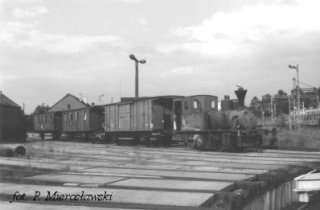Local railway train
- track width: 1435 mm
- steam locomotive: TKb nr 2
- 4th class passenger/luggage car: 111 168
- 3rd class car: Kreisbahn Briesen nr 2
- 1st/2nd class car: 014 506 ABi

Local railways always used to be the method of transport operating in a chosen, closed area, serving on short distances and often offering specialised services. Sometimes locally important connections were ahead of primary lines, but in most cases local lines were the “second shod” – supplementing and “tightening” the main railway network. They were their delivery ways, increasing the transport as well as incomes.
This process had become particularly apparent on the turn of the 19th century. With the gradual development of local industry that required larger than before supplies of raw material and fuel and also the delivery of produced goods. Horse carriage transport was no longer capable of handling it, so the only possible choice was the “little” railway.
Governments of many countries quickly saw the need of building local railways. Development of regional transport becomes a chance of industrial growth. Rather large investment costs are expected, though, so the governments don’t see the point in spending national goods on this sort of undertakings of extremely local character. Instead treasury warrants and privileges declared in law quickly launch private and municipal railway initiatives. The industry catches up soon and its offer towards investors is getting bigger. It features light and cheap rolling stock, technical devices, prefabricated track segments, small bridges and easy to assemble buildings. Highly specialised companies offering not only complex deliveries but even building local lines are starting to appear. Along with them are operating companies that lease rolling stock and provide transport on demand. A large and complex railway system is gradually building up in Europe, including the areas of partitioned Poland – the Pomerania, Silesia, Wielkopolska (Greater Poland) and Galicia.
Unfortunately, not much has left of the little railway to this day. There are the old lines, often liquidated in our country. Particularly rare is the rolling stock – locomotives and cars built exclusively for local transport. Despite that several pieces of history have been saved. The PSMK collection features a couple of items that have “local” origins, which together can make a complete passenger train of local standard gauge railway – nearly identical to trains that had been operating in Lower Silesia or Pomerania on the turn of the 19th century. The train is arranged from 2-axle small steam tank locomotive and two or three light 2-axle passenger cars. Currently all of these vehicles await or are being repaired.
These units were built in 1889-1925 by the following factories:
- TKb nr 2 lovomotive: Orenstein & Koppel AG Berlin-Drewitz (serial number: 10672/1925);
- 4th class passenger/luggage car number 111 168: L. Steinfurt AG Königsberg (1889 year);
- 3rd class car Kreisbahn Briesen nr 2: Beuchelt & Co Grünberg (1898 year)
- 1st/2nd class car number 014506 ABi: Gebrüder Hofmann AG Breslau (1897 year)





